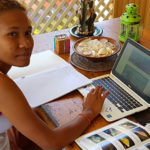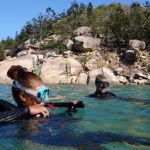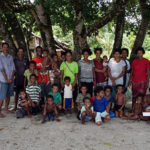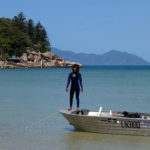Over the past 12 years, Dr. Andy Lewis has been running ecotourism activities for True North Adventure Cruises. In that time, he has taken passengers to visit some of the best coral reefs in the world in the remote eastern islands of Papua New Guinea (PNG). During that time, he has also witnessed two key factors having a rapid effect on Papua New Guinea marine conservation.
“The population of PNG has grown rapidly in recent years – and it continues to grow,” he says. “Also, there are almost no Marine Protected Areas (MPAs) in PNG. These two key factors are having a devastating effect on marine life.”
Educational opportunities for girls and women are very limited in PNG, with most young women married in their late teens. By the time they’ve reached their early 20s they’ve often had multiple children. It’s easy to see the effects of a burgeoning underwater anywhere near a village of more than 50 people.
Fishing is still the main way that coastal people gather food, and close to villages there is a clear lack of large predatory fish such as groupers and snappers. Villagers often chronically overfish the reef, consequently catching and eating mostly small fish less than 6 inches (15 cm) long.
“We know from studies in Australia that MPAs really do work, with greater numbers of fish, and larger fish, in the marine reserves after only a few years of closure to fishing,” says Lewis. “Most importantly, there’s clear evidence that the larger fish in those reserves export larvae to replenish populations on nearby reefs that are open to fishing, resulting in better overall catches for fishers.”





A budding sea woman
Dr. Lewis concluded from these observations that two courses of action were necessary:
- For the incredible reefs of PNG to survive into the future as food producers and scuba-diving destinations, the local communities must understand the benefits of MPAs. They must receive assistance to set them up and manage them.
- Women need to be given more opportunities for education so that the birth rate can fall and keep the population within reasonable limits.
In 2012, Dr. Lewis met Lorie on the beautiful island of Fergusson in Milne Bay.
Then just 18 years old, Lorie told Andy she wanted to be a biologist, “so I can understand the forest and reefs of my island and stop people like these loggers coming in and spoiling our environment.”
“I resolved there and then to do everything I could to help this young woman realize that dream,” Lewis says. “We exchanged contact details and after I came back to Australia, I sent all my old biology text books to the school for Lorie to use, and in 2013, she graduated high school.”
Lorie’s dream was to come to Australia and study biology, but unfortunately there are no scholarships available at the undergraduate level. The fees for an overseas student to study science at James Cook University in Townsville are more than $30,000 per year.
In 2015 Lorie joined True North for a six-night voyage through the Louisiade Archipelago, where Dr. Lewis taught her to snorkel, so she could see the incredible coral reefs of her homeland.
“She was a natural water-woman, and within an hour of being shown how to use a mask and snorkel, she was free-diving down the outer edge of Deboyne Lagoon where the wall drops to 1,300 feet (400 m),” he says. “Over the next five days we were able to see some of the best reefs in PNG and give Lorie a crash course in identifying the main groups of fishes and corals.”
Direct training
In 2017, after realizing that raising funds for Lorie to do a degree course in Australia was going to be impossible, and that the threats facing coral reefs globally were quickly increasing, Dr. Lewis decided to bring Lorie to Australia to train her directly in the skills she would need to begin the Marine Reserve program back home.
“We setup a GoFundMe page to raise some money, and we soon had enough to cover airfares and start scuba training,” he says. “Within weeks, Lorie completed her Open Water, Advanced Open Water, and Rescue Diver training, completing about 25 dives around Magnetic Island.”
Lorie’s study time was spent learning underwater survey techniques, taking loads of digital photographs, and coming back to the lab to study results. She also learned how to use GPS technology to record exactly where she had been and how to make a basic PowerPoint presentation about marine reserves to use when discussing reef management with local people in her area.
Overall, Lorie was in Australia nearly three months, and the skills she acquired showed how cost-effective this direct method of training can be.
“For a few thousand dollars, we got her to a level of capability that she would not have reached even after a 3-year, $100,000 university science degree,” says Lewis.
Lorie is now back in PNG and visiting the local villages in her area to discuss the Marine Reserve concepts and encouraging the girls to keep up with their studies.
Training more sea women
Interest in the training program continues to build, and Andy’s GoFundMe campaign has now raised over $8,000, enough to bring Lorie and perhaps one other young woman to Magnetic Island this year for a second round of training.
“It would be great to bring a small group of perhaps six PNG ladies here and run a proper short course for all of them together, bringing in some Australian marine science women to lecture the group and inspire them even further,” he says.
“These young women from the jungle islands of Papua could be the beginning of a movement that builds momentum for sustainable management of the natural resources of PNG and also empowers the younger generation of girls in PNG to follow their dreams.”
Read more about and contribute to the foundation at www.coralseafoundation.net.
Deborah Dickson-Smith is one half of Diveplanit, a dive travel website she manages with her partner Simon Mallender, based in Australia.
The post How the Sea Women of Melanesia Can Save Coral Reefs in Papua New Guinea appeared first on Scuba Diver Life.
from Scuba Diver Life https://ift.tt/2JdZIkz
No comments:
Post a Comment